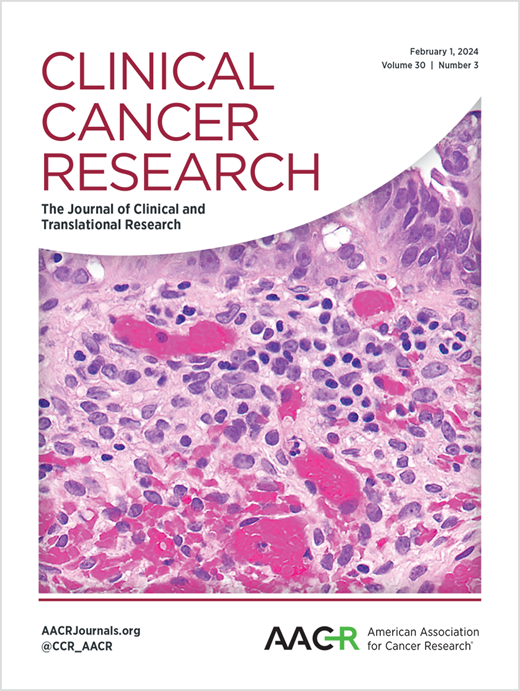小细胞肺癌(SCLC)患者塔拉他单抗暴露-疗效和暴露-安全性关系的剂量选择
IF 10.2
1区 医学
Q1 ONCOLOGY
引用次数: 0
摘要
目的:tarlatamab是一种针对delta-样配体3 (DLL3)的领先的半衰期延长双特异性t细胞参与(BiTE®)免疫疗法,目前被批准用于治疗在铂基化疗期间或之后疾病进展的成年小细胞肺癌(SCLC)患者。在这里,我们报告了塔拉他单抗暴露-反应关系,为SCLC患者的剂量选择提供信息。实验设计:采用来自delphi -300和delphi -301研究的合并数据,将药代动力学数据与疗效[暴露-反应(ER)分析]相关联,以评估疗效和安全性措施。疗效指标包括客观缓解率、疾病控制率、肿瘤大小自基线的最佳变化、无进展生存期和总生存期。安全性事件包括治疗引起的不良事件(teae)、治疗相关不良事件(TRAEs)和主要的teae,包括细胞因子释放综合征(CRS)、中性粒细胞减少症和神经毒性(包括免疫效应细胞相关神经毒性综合征(ICANS))。还评估了患者特定因素的影响。研究的剂量范围为0.003毫克至100毫克Q2W和200毫克Q3W。结果所有评估的疗效指标均与ER呈正相关。在10mg Q2W的临床治疗方案下,达到了接近最大的疗效。以下3级事件:teae、TRAEs、CRS和包括ICANS在内的神经毒性,未发现与暴露的关系。随着暴露量的增加,出现3级中性粒细胞减少症的患者比例呈浅趋势。结论:本分析支持10mg Q2W方案,无需根据年龄、种族、体重、免疫原性、既往治疗次数或疾病负担调整剂量。本文章由计算机程序翻译,如有差异,请以英文原文为准。
Tarlatamab exposure-efficacy and exposure-safety relationships to inform dose selection in patients with small cell lung cancer (SCLC).
PURPOSE
Tarlatamab is a first-in-class, half-life extended bispecific T-cell engager (BiTE®) immunotherapy targeting delta-like ligand 3 (DLL3) currently approved for the treatment of adult patients with small cell lung cancer (SCLC) with disease progression on or after platinum-based chemotherapy. Here we report tarlatamab exposure-response relationships to inform dose selection in patients with SCLC.
EXPERIMENTAL DESIGN
Pharmacokinetic data were correlated with therapeutic effect [exposure-response (ER) analyses] for efficacy and safety measures using pooled data from DeLLphi-300 and DeLLphi-301 studies. Efficacy measures included objective response rate, disease control rate, best change from baseline in tumor size, progression-free survival, and overall survival. Safety events included treatment-emergent adverse events [TEAEs], treatment-related adverse events [TRAEs], and TEAEs of interest including cytokine release syndrome [CRS], neutropenia, and neurologic toxicity including immune effector cell-associated neurotoxicity syndrome [ICANS]). Effects of patient specific factors were also assessed. Doses ranging from 0.003 mg to 100 mg Q2W and 200 mg Q3W were explored.
RESULTS
Significant positive ER relationships were established for all evaluated efficacy measures. Near maximal efficacy was reached at exposures associated with the clinical regimen of 10 mg Q2W. No relationships with exposure were identified for the following grade ³ 3 events: TEAEs, TRAEs, CRS, and neurologic toxicity including ICANS. A shallow trend was observed for higher percentage of patients experiencing grade ³ 3 neutropenia with higher exposures.
CONCLUSIONS
This analysis supports 10 mg Q2W regimen and that no dose adjustment is necessary based on age, race, bodyweight, immunogenicity, number of prior therapies or disease burden.
求助全文
通过发布文献求助,成功后即可免费获取论文全文。
去求助
来源期刊

Clinical Cancer Research
医学-肿瘤学
CiteScore
20.10
自引率
1.70%
发文量
1207
审稿时长
2.1 months
期刊介绍:
Clinical Cancer Research is a journal focusing on groundbreaking research in cancer, specifically in the areas where the laboratory and the clinic intersect. Our primary interest lies in clinical trials that investigate novel treatments, accompanied by research on pharmacology, molecular alterations, and biomarkers that can predict response or resistance to these treatments. Furthermore, we prioritize laboratory and animal studies that explore new drugs and targeted agents with the potential to advance to clinical trials. We also encourage research on targetable mechanisms of cancer development, progression, and metastasis.
 求助内容:
求助内容: 应助结果提醒方式:
应助结果提醒方式:


